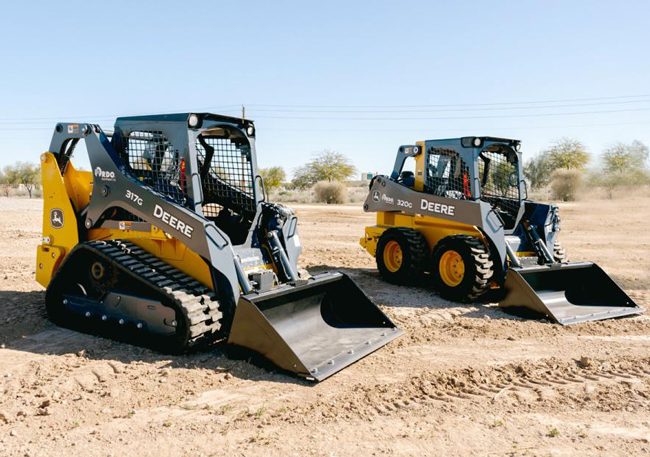Skid steer loaders are a common sight on construction projects of all kinds since they can do anything from excavating and landscaping to waste collection. Wheeled skid steers and compact track loaders are the two major models to select from. Skid steers and small track loaders perform similar tasks and can be used interchangeably. The most significant distinction? Track loaders run on tracks, whereas skid steers have wheels. The type you select can have a big influence on the success of your project, so it’s critical to understand which jobs each is best suited for.
Skid steers and small track loaders have many similarities, but they also have unique characteristics and capabilities that distinguish them. Consider the following aspects carefully while selecting the correct loader for your project.
Terrain
- Skid steers with wheels perform admirably on hard, flat terrain. A skid steer is generally the best choice if your job site is on concrete, asphalt, or similar built surface. Wheels are less prone to harm these surfaces and allow the machine to travel swiftly across flat terrain. However, wheels do not perform well on snow or damp conditions, so you may need to install winter tires or wait for the site to attempt if the ground is slick.
- Compact track loaders are a better alternative for undeveloped land, uneven terrain, and damp or slippery job sites. Whereas a skid steer may sink into sand or mud, a track loader may remain steady. This is due to the tracks’ ability to uniformly distribute the machine’s weight and provide additional traction to avoid slippage.
Speed
- A skid steer is generally the best solution if you need a fast-moving equipment. Skid steers are lightweight and lack slow-moving tracks, allowing them to move significantly quicker on flat terrain than track loaders. They are also more suited to making abrupt bends and navigating busy job locations in less time.
- Because track loaders are slower than skid steers, operations that require traveling back and forth over vast distances may take longer to execute. This is usually not an issue for lengthier projects or localized jobs, but it should be considered for initiatives on a tight deadline. However, using a track loader on unstable terrain will result in fewer project delays.
Maneuverability
- Skid steers have the ability to perform extremely abrupt turns and spin practically in place, making them ideal for maneuvering in small locations. A compact skid steer is a fantastic alternative if you have a busy job site or limited area to work in.
- Because track loaders have fixed axles, they have the same turning capabilities as wheeled skid steers. They are, however, bigger and travel slower than skid steers, thus they may not perform as well in small locations. Three-point rotations are also advised for these machines
Power
- Skid steers are lighter than track loaders and have a greater center of gravity. While bigger versions may still do heavy-lifting duties, their weight capability may be less than that of its tracked counterparts. Their diminished traction can also make it more difficult to push high-resistance materials.
- Tracks distribute weight more evenly and increase touch with the ground. This permits track loaders to lift greater weight and push more weight without sliding. Some small track loaders have more horsepower than wheeled skid steers, making them better suited for high-power operations.
Cost
- The cost to rent or buy a skid steer varies depending on region and manufacturer, although ones with wheels usually cost less upfront and are less expensive to maintain than track loaders. Skid steers can also save money on gasoline and shipping because of their lightweight construction and smaller engines.
- Compact track loaders are often more expensive to purchase or hire, and tracks are more expensive to replace when broken than tires. If you decide to buy a track loader for your project, you should account for potential maintenance and damage expenses in your budget.
Maintenance
- A skid steer is your best option if you want a machine that is simple to maintain. Skid steers normally require less regular maintenance than track loaders, and if something goes wrong, parts are considerably easier to replace. Wheels also allow cleaning and examining the undercarriage easier, which is useful for time-pressed crews.
- Because the tracks on a track loader can nearly entirely cover the undercarriage, expect to spend more time cleaning and maintaining it. This may be a difficult process for one-time projects or those on a tight budget, therefore many project owners opt to rent rather than buy a skid steer to avoid spending extra time and money on upkeep.
Site Cleanup
- While a machine’s skills are crucial, you should also evaluate how it will influence the site once the task is over. Tires are often kinder on hard surfaces like as concrete and asphalt, whereas tracks can cause damage. If your project necessitates working on certain surfaces, using a skid steer can save you from having to repair surface damage afterwards.
- When using a track loader, you can minimize damage to grass and other soft surfaces. Track loaders, unlike wheeled skid steers, do not rip up the dirt or leave large ruts behind since its tracks are level and uniformly distribute a machine’s weight. While track loaders might cause damage to hard surfaces, they will save you time during site cleaning for landscaping work.






